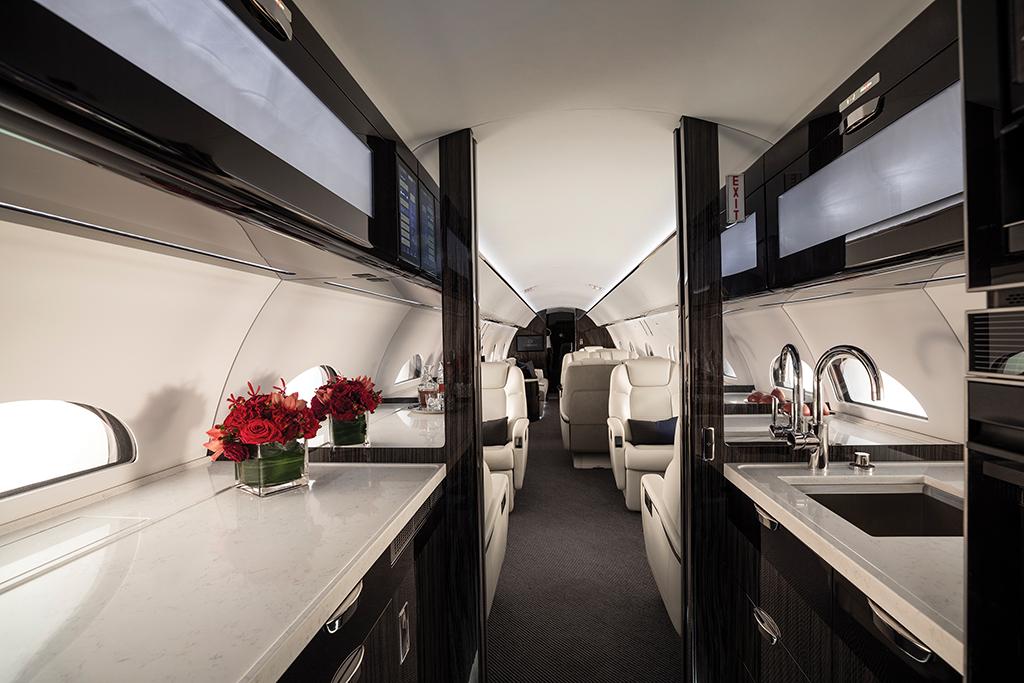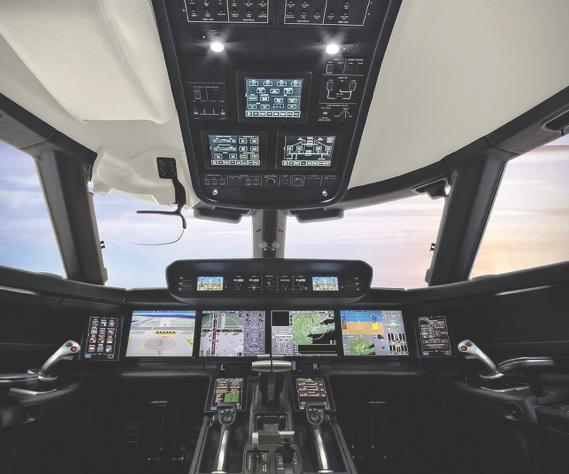
Gulfstream G500 operators live in a 500+ kt.-world where few, if any, competitive aircraft can catch them. They tell BCA they only slow down to Mach 0.85 cruise when they need to stretch range to the maximum. And many say their normal cruise speed is Mach 0.90, equivalent to 516 KTAS in ISA conditions above the tropopause, even faster at lower altitudes where it’s warmer.
Many of these operators stepped up from the GIV series, aircraft with smaller cabins that are 30 kt. slower, lower flying and considerably more fuel-thirsty. Some changed over from older Dassault Falcons and Bombardier Challenger aircraft, saying they chose the G500 because of its higher cruise speeds and more modern systems.
“We’re in Falcon Country,” says Ole Christiansen, CEO of Blackbird Air Charter in Billund, Denmark. However, the company is selling its Falcon 2000S because the operator needs more range and speed. Says Christiansen, “Our owner is a pilot who believes time is of the essence.” His first choice was the Bombardier Global 7000 (now Global 7500), but the delivery slot was delayed due to snags in the certification process. Christiansen noted all new Falcons achieve better fuel efficiency at Mach 0.80 than the G500 does at Mach 0.85.

“We asked Gulfstream to show us the G500’s fuel efficiency when slowed to Mach 0.80. Savannah responded that the aircraft couldn’t fly efficiently at such a slow speed. At that point, our owner was sold on [the G500],” says Christiansen. He says his company typically flies the G500 at Mach 0.87 on trips between Denmark and the United Arab Emirates or Africa. Often, the owner pushes up speed to Mach 0.90 if fuel reserves are not a concern.
Stepping up to the G500 was a normal progression in the Gulfstream family for Houston-based Service Corp. International (SCI), says flight department manager Mike Wilson. SCI most recently operated three G450s. Wilson says the new aircraft typically cruises at Mach 0.90, matching the G450’s specific range performance at Mach 0.84. He only slows down to Mach 0.85 for the occasional transatlantic mission between South Texas and Europe.
A senior pilot for another Texas firm that operates three G500s for a high-net-worth individual, says he usually flies at Mach 0.90 in the low to mid-thirties, where warmer OATs yield 515-523 KTAS cruise speeds. “Our principal formerly owned Falcons,” he says. The G500 affords this owner 35-40-kt. higher cruise speeds, albeit with higher fuel consumption than the French fuel misers cruising at slower speeds.
“We looked at the Global 5000, but it was too heavy and too fuel-thirsty,” says a flight department manager who is based in the Northeast U.S. “We had a Falcon 7X on order, but it was delayed. Then, we became a U.S. launch customer for the Falcon 5X, but that program was canceled. And, deep down, we always knew we wanted a Gulfstream.” The firm bought a 2018 G500 that it uses primarily for transcontinental U.S. missions flown at Mach 0.90.

Bob Snyder, who flies for Sedgwick Azure of Memphis, Tennessee, says that his company, during its new aircraft search, looked at the older G550, Global 6000 and Falcon 7X. “However, our CEO likes the latest technology, especially safety technologies and active side-stick controls.” High tech, as well as high cruise speed, sold Sedgwick on the G500, says Snyder. On trips up to 4,500 nm, Snyder pushes up speed to Mach 0.90. He admits he initially slowed down to Mach 0.88 for one trip from Milan to Jacksonville, Florida, because of headwinds. But later, when fuel reserves proved fat, he pushed back up to Mach 0.90.
Who Owns a G500? How Do They Fly?
There now are close to 50 G500s in service. About two-thirds of the fleet is registered in the U.S., with ownership split between corporations and private individuals. Oil-and-gas exploration companies, Sentry Insurance, Van Tuyl Group and Enterprise Holdings, plus Eli Lilly, Rooney Holdings, Data Management Products and a few commercial finance firms are among the corporate operators. One U.S.-registered aircraft is physically based in Moscow with Avangard Aviation and another N-registered G500 is based at Montreal Pierre E. Trudeau International Airport with Nova Steel.


 Five G500s are flown by Doha-based Qatar Executive, the Middle East launch customer for the model. The operator has three more G500s slated for delivery, part of a billion-dollar Gulfstream jet order signed in 2019.
Five G500s are flown by Doha-based Qatar Executive, the Middle East launch customer for the model. The operator has three more G500s slated for delivery, part of a billion-dollar Gulfstream jet order signed in 2019.
Three G500s are based in Russia and single aircraft are based in Austria and Switzerland. A few are carefully cloaked in the Cayman Islands, Malta and Isle of Man registry for very-low-profile private owners.
All but a few survey respondents say their aircraft are outfitted with forward galleys. The three-section cabins typically are configured with a forward, four-chair section; a four-seat conference grouping, either flanked by two facing chairs or a credenza in mid-cabin; and an aft private stateroom with a divan on one side and one or two chairs on the other side. Aircraft with aft galleys tend to be tail heavy. Some even require ballast in the nose to keep the aircraft in the allowable CG range when ferrying with crew only and light fuel loads.
As expected, corporate fleet operators fly two to three times as many annual hours as small flight departments supporting individuals or family businesses. Yearly utilization ranged from 250 to 700 hr. among respondents to this survey prior to this year’s downturn due to COVID-19. Operators tell BCA aircraft utilization has declined by as much as 75%. Average flight time is just 2 hr.
“We normally fly 600-700 hr. I doubt we’ll fly more than 250 hr. this year,” says Sedgwick’s Snyder. The fleet has accumulated more than 12,500 hr. of total flight time, but the average annual utilization now is only 187 hr. per aircraft, according to Gulfstream Aerospace.
Most respondents say they would be comfortable flying the aircraft 5,000-5,200 nm. The longest missions have spanned 10.0-10.5 hr. That’ is sufficient to fly from London to Los Angeles, Beijing or Tokyo; from New York to Cairo, Buenos Aires, Argentina, or Lagos, Nigeria; or from Moscow to Dallas, Seattle or New York.

Some cap max range at 4,400-4,500 nm, but that is because they are pushing up cruise speed to Mach 0.88-0.90. That’s London to Seattle, Tokyo to Los Angeles, or Dallas to Paris at nine-tenths the speed of sound.
Those numbers, though, are predicated on keeping aircraft empty weight in check. Gulfstream says a BCA-equipped G500 weighs in at 46,850 lb. Most respondents told us their aircraft tip the scales at 47,000-47,400 lb.
Anticipating that customers would load up their aircraft with hefty options, Gulfstream bumped up maximum ramp and takeoff weights by 2,750 lb. during late-stage development. The weight increases assure that even very-well-equipped airplanes still can carry 10-11 passengers with full fuel.
What Operators Praise, What They Pan
Exceptional performance tops the five favorite features list for most respondents. The G500 has the sportiest thrust-to-weight ratio of any aircraft in its class, enabling it climb through FL 370 in 15 min. and level-off at FL 430.

It also cruises efficiently at 488 to 500 KTAS. Operators ballpark fuel consumption at 3,000-3,200 lb. for the first hour and 2,500 lb./hr. for subsequent hours. Scott Farrar at Eli Lilly says his two G500s burn 30% less fuel than the GIV-series aircraft they replaced.
Cabin comfort, quiet and high pressurization rank high with operators. “It’s a big jump up from the GIV,” says Farrar. The cabin cross-section is a squared oval, rather than circular shape of first-generation Gulfstream jets. It’s 7 in. wider and 2 in. higher than the GIV. The 10.69-psi pressurization system provides a cabin altitude about 2,500 ft. lower than the GIV at the same cruise altitude. At FL 510, the aircraft’s maximum certified altitude, G500 cabin altitude is 4,850 ft. Lower cabin altitude results in reduced air-travel fatigue for passengers. “It’s a night and day difference for passengers,” says Farrar.
Cabin window size is another popular feature. The wide oval windows are adapted from the G650, so they’re 16% larger in area than on legacy Gulfstream models.
Gulfstream’s Symmetry flight deck, powered by Honeywell Primus Epic, received plaudits because of systems integration and shortened checklists. Christiansen, for instance, says his crews can go from dark cockpit to taxi in 7-10 min. BCA Contributor James Albright, who flies a G500 based in the Northeast U.S., says checklists are easy, the touchscreen controls are intuitive, and they provide multiple ways of entering data.
Some pilots said they experienced a steep learning curve in making the transition between early Gulfstream cockpits and the radically changed Symmetry flight deck. The G500 has 10 touchscreen controls, including three on the overhead panel, that control and display avionics and systems functions with left/right, up/down swiping motions, plus press and release positive-action soft buttons. The touchscreen feel is far different than that of consumer electronic devices because Gulfstream engineers wanted to make sure they weren’t prone to inadvertent actuation. It takes practice to adjust one’s touch, hold and release technique to make the system work as intended, they say.
Overall, Symmetry, the sidestick controls and the digital flight control system received high marks. “The fly-by-wire flight controls are amazing,” says Hangar One’s Joe Statt, who flies a G500 based at Scottsdale, Arizona. “It’s fun to fly, a pilot’s airplane. It’s also super-efficient for its size and speed.” He says he flew the aircraft from Wilmington, Delaware, to Kona, Hawaii, in 9.5 hr. and had plenty of fuel to spare.
“I appreciate the increased room on the flight deck because of the sidesticks,” says Hector Moctezuma, who flies for Franklin Mountain Assets. “We also like the aesthetics, the ramp presence. It looks like a baby G650.”
The G500 has had a relatively trouble-free entry-into-service period, operators say. But it has had its share of early teething pains with serial number units. Ice shedding from the fan spinners of the Pratt & Whitney Canada PW814GA engines, for example, has both alarmed some passengers and caused minor damage to the engine inlet fan ducts. Early aircraft lacked a takeoff and landing (TOLD) V speed and distance calculation function. A few operators report BIT check failures of the BAe active sidesticks that can ground the aircraft.
A few early serial number operators have experienced multiple AOG squawks, usually related to the same components. Many of these problems appear to be related to operating system software. The G500 is the most sophisticated, integrated business aircraft yet built by the firm.
Gulfstream also was caught up in the FAA’s considerably tougher certification gauntlet that was put into place in the wake of the Boeing 737 MAX accident inquiries. It took several months, for instance, to earn approval for using Type IV deicing fluid, including adding a requirement to operate the wing anti-ice system for at least 4 min., but no longer than 20 min., before takeoff.
As Albright notes at his Code 7700 website, many of the shortcomings were corrected with the mid-2020 Block 1 improvement package, including ASC 022, which includes a heavier, redesigned fan spinner to shed ice more efficiently, plus a new N1 shaft front bearing. In addition, there’s revised FADEC software, ASC 901, that updates the Symmetry software package; ASC 01A, which adds TOLD computations; and ASC 025, which updates the fuel quantity management system. Block 1 essentially contains all the improvements wrapped into the G600 entry-into-service hardware and software package.
Other areas needing improvement are not addressed by the Block 1 package. Among these are an automatic acoustical curtain stow feature that slams open the door when flaps are selected to 10 deg. or greater on approach, thereby disturbing passengers. Next, the preselect refuel quantity shuts off prematurely during refilling, unless the APU or external power is powering the IRSes. It’s also difficult to build a VFR approach into the FMS to a runway not served by an instrument approach. The flight-guidance system and autothrottle have no coupled one-engine-inoperative go-around capability. The autobrake system is very smooth and powerful, but it lacks a brake-to-vacate at a specified taxiway intersection function.
A few early serial-number airplanes had interior completion quality-control issues and minor exterior paint peeling.
G500 autothrottle operation is somewhat of an art form because of the initial engagement criteria on takeoff roll, says Albright. The engines often spool up at different rates and there may be an rpm split when both throttles are pushed up to the same angle. To engage, the throttles have to be advanced to at least 19 deg. and the split in engine rpm may not exceed 10%. For instance, if the left engine tach reads 45%, the right engine tach must be within 4.5% (10% of the split) of the left.
Yet, a large majority of operators praised Gulfstream for its customer support and AOG response. SCI’s Wilson said he was stuck in Grand Junction, Colorado, with an AOG problem. Gulfstream dispatched its Field and Airborne Support Team (FAST) from Long Beach, California, and had Wilson’s aircraft in airworthy condition in several hours. Christiansen and Snyder were just as enthusiastic about support from the Savannah, Georgia, manufacturer, listing it among their five favorite features. Albright says his aircraft was AOG with a throttle quadrant snag. Gulfstream had a replacement part delivered to his hangar in less than 24 hr. Farrar said Eli Lilly has experienced next-day parts deliveries as well.
Some operators, though, say that Gulfstream’s product support specialists are hard to reach. They say Dassault now provides better customer support for its Falcon Jets.
FlightSafety International, the sole provider of initial and recurrent training for the G500 and G600, received positive mention. Some early class students said that its instructors struggled to answer complex questions about the aircraft. Others acknowledged that everybody experienced a sharp-edged learning experience in the early weeks of the program.
On Balance
Operators say they’re confident that Gulfstream will continue to make improvements to the aircraft to increase operating flexibility and utility. As Albright notes, minimum OAT for engine start has been decreased from -20C to -40C; restrictions for using autothrottle for takeoff have been relaxed; the aft lav baggage door now may remain open up to 45,000 ft., a 5,000-ft. increase; some checklists have been even more streamlined; weather radar and brake temp checks are no longer required; and some non-essential advisory CAS messages have been eliminated.
Gulfstream officials fully appreciate that the G500 represents more than just a new model. It’s a step change in aircraft design that is the basis for the new G700 flagship and other unannounced models in the pipeline. Thus, they are committed to ironing out the G500’s wrinkles. And it appears they are succeeding.
“We’re diehard Gulfstream fans,” says Albright, whose firm flew the GIV and G450 prior to acquiring its G500. “We couldn’t be happier,” says Farrar. “We love this aircraft,” says Christiansen. With comments such as these, the G500 is off to a strong start.





